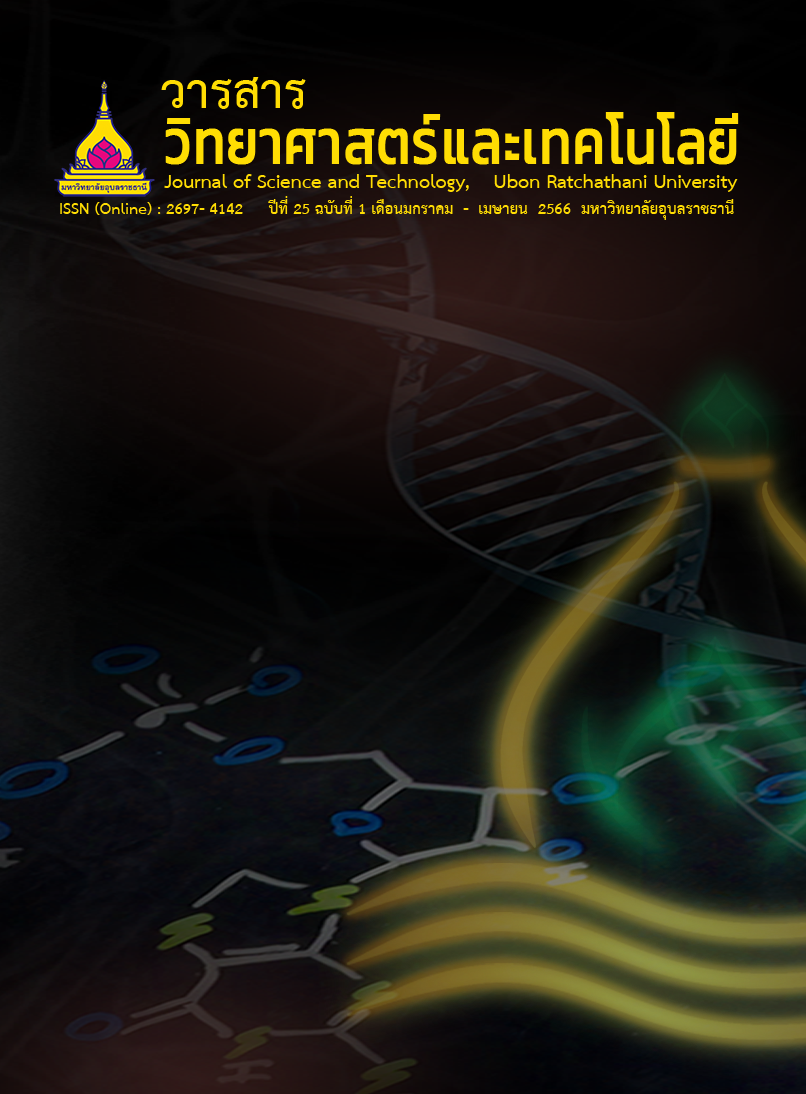ปริมาณโปรตีน สารออกฤทธิ์ทางชีวภาพ และฤทธิ์ต้านอนุมูลอิสระของกาวไหมที่สกัดด้วยวิธีการต่าง ๆ
Main Article Content
บทคัดย่อ
งานวิจัยนี้มีวัตถุประสงค์เพื่อตรวจสอบปริมาณโปรตีน และปริมาณสารออกฤทธิ์ทางชีวภาพ และศึกษาฤทธิ์ต้านอนุมูลอิสระของกาวไหมที่สกัดจากไหมพันธุ์ลูกผสม Bombyx mori) ด้วยวิธีการสกัดต่าง ๆ ในการศึกษานี้ใช้วิธีการสกัด 3 วิธี คือ การสกัดด้วยน้ำกลั่น การสกัดด้วยสารละลายโซเดียมคาร์บอเนต และการสกัดด้วยสารละลายขี้เถ้าที่เหลือจากการเผาข้าวหลาม ผลการทดลองแสดงให้เห็นว่าการสกัดด้วยสารละลายโซเดียมคาร์บอเนต เป็นเวลา 30 นาที มีร้อยละของการลอกกาวไหม (%Degumming) ที่มากที่สุด คือ ร้อยละ 25.483±4.039 จากการวิเคราะห์ปริมาณโปรตีนด้วยวิธี Bradford assay พบว่ากาวไหมที่สกัดได้จากการสกัดด้วยสารละลายขี้เถ้า เป็นเวลา 30 นาที มีปริมาณโปรตีนมากที่สุด (164.073 ± 0.059 mg/g dry weight) การวิเคราะห์ปริมาณสารประกอบฟีนอลิก และปริมาณสารฟลาโวนอยด์แสดงให้เห็นว่ากาวไหมที่ได้จากการสกัดด้วยสารละลายโซเดียมคาร์บอเนต เป็นเวลา 30 นาที มีปริมาณของสารประกอบฟีนอลิก (428.254 ± 0.099 mg gallic acid equivalent/g dry weight) และปริมาณสารฟลาโวนอยด์ (7.435 ± 0.029 mg quercetin equivalent/g dry weight) สูงที่สุด จากการศึกษาฤทธิ์ต้านอนุมูลอิสระ พบว่าเมื่อทดสอบด้วยวิธี ABTS decolorization scavenging effect และวิธี Potassium ferricyanide reducing power assay กาวไหมที่ได้จากการสกัดด้วยสารละลายโซเดียมคาร์บอเนต เป็นเวลา 90 นาที มีฤทธิ์ต้านอนุมูลอิสระสูงที่สุด อย่างไรก็ตามเมื่อทดสอบด้วยวิธี DPPH radical scavenging assay พบว่ากาวไหมที่ได้จากการสกัดด้วยน้ำกลั่น เป็นเวลา 90 นาที มีฤทธิ์ต้านอนุมูลอิสระสูงที่สุด ข้อมูลที่ได้จากการศึกษานี้อาจมีประโยชน์ต่อการสกัดและการนำกาวไหมไปใช้ในอุตสาหกรรมอาหาร เครื่องสำอาง วิศวกรรมเนื้อเยื่อ และชีวการแพทย์
Article Details

อนุญาตภายใต้เงื่อนไข Creative Commons Attribution-NonCommercial-NoDerivatives 4.0 International License.
บทความที่ได้รับการตีพิมพ์เป็นลิขสิทธิ์ของ วารสารวิทยาศาสตร์และเทคโนโลยี มหาวิทยาลัยอุบลราชธานี
ข้อความที่ปรากฏในบทความแต่ละเรื่องในวารสารวิชาการเล่มนี้เป็นความคิดเห็นส่วนตัวของผู้เขียนแต่ละท่านไม่เกี่ยวข้องกับมหาวิทยาลัยอุบลราชธานี และคณาจารย์ท่านอื่นๆในมหาวิทยาลัยฯ แต่อย่างใด ความรับผิดชอบองค์ประกอบทั้งหมดของบทความแต่ละเรื่องเป็นของผู้เขียนแต่ละท่าน หากมีความผิดพลาดใดๆ ผู้เขียนแต่ละท่านจะรับผิดชอบบทความของตนเองแต่ผู้เดียว
เอกสารอ้างอิง
Kunz, R.I. and et al. 2016. Silkworm sericin: Properties and biomedical applications. BioMed Research International. 2016: 8175701.
Padamwar, M.N. and Pawar, A. 2004. Silk sericin and its applications: A review. Journal of Scientific and Industrial Research. 63: 323-329.
Chlapanidas, T. and et al. 2013. Sericins exhibit ROS-scavenging, anti-tyrosinase, anti-elastase, and in vitro immunomodulatory activities. International Journal of Biological Macromolecules. 58: 47-56.
Gupta, D., Chaudhary, H. and Gupta, C. 2015. Sericin-based polyester textile for medical applications. The Journal of The Textile Institute. 106(4): 366-376.
Ahsan, F. and et al. 2018. An insight on silk protein sericin: From processing to biomedical Application. Drug Research. 68(6): 317-327.
Wu, J.H., Wang, Z. and Xu, S.Y. 2007. Preparation and characterization of sericin powder extracted from silk industry wastewater. Food Chemistry. 103(4): 1255-1262.
Yun, H. and et al. 2013. Extraction conditions of Antheraea mylitta sericin with high yields and minimum molecular weight degradation. International Journal of Biological Macromolecules. 52: 59-65.
Zhao, Z.L. and Zhang, Y.Q. 2020. Greener degumming production of layered sericin peptides from a silkworm cocoon and their physicochemical characteristics and bioactivities in vitro. Journal of Cleaner Production. 261: 121080.
Zaguri, M. and et al. 2021. Protein quantification in ecological studies: A literature review and empirical comparisons of standard methodologies. Methods in Ecology and Evolution. 12(7): 12401-1251.
Rueangsuksud, P. and Punnongwa, W. 2022. Physicochemical properties and antioxidant activity of Japanese purple sweet potato starch modified by acid and heat treatments. Journal of Science and Technology, Ubon Ratchathani University. 24(2): 72-80. (in Thai)
Chandra, S. and et al. 2014. Assessment of total phenolic and flavonoid content, antioxidant properties, and yield of aeroponically and conventionally grown leafy vegetables and fruit crops: A comparative study. Evidence-Based Complementary and Alternative Medicine. 2014: 253875.
Kansing, S. and et al. 2017. Comparison of protein extraction methods and protein pattern. KKU Science Journal. 45(1): 128-137. (in Thai)
Srisorn, P. and et al. 2020. Effect of frozen storage on quality of Chormuang dough contains pregelatinized Hom Nil flour. Journal of Science and Technology, Ubon Ratchathani University. 22(3): 92-102. (in Thai)
El Jemli, M. and et al. 2016. Radical-scavenging activity and ferric reducing ability of Juniperus thurifera (L.), J. oxycedrus (L.), J. phoenicea (L.) and Tetraclinis articulata (L.). Advances in Pharmacological and Pharmaceutical Sciences. 2016: 6392656.
Zhang, Y.Q. 2002. Applications of natural silk protein sericin in biomaterials. Biotechnology Advances. 20(2): 91-100.
Fan, J.B. and et al. 2009. Antioxidant activities of silk sericin from silkworm Bombyx mori. Journal of Food Biochemistry. 33(1): 74-88.
Kato, N. and et al. 1998. Silk protein, sericin, inhibits lipid peroxidation and tyrosinase activity. Bioscience, Biotechnology, and Biochemistry. 62(1): 145-147.


